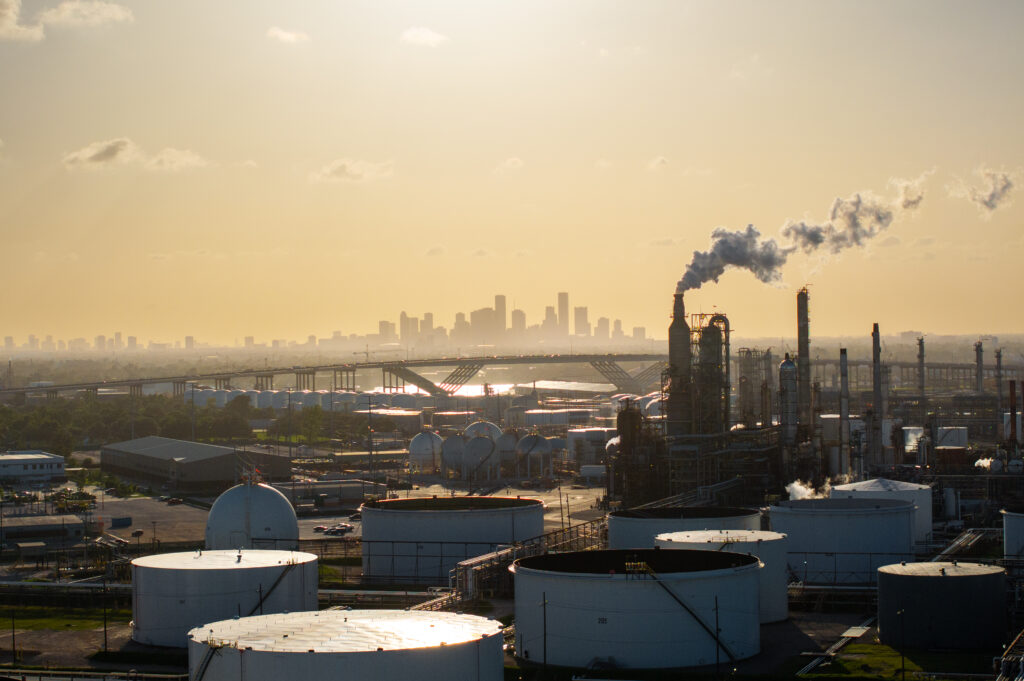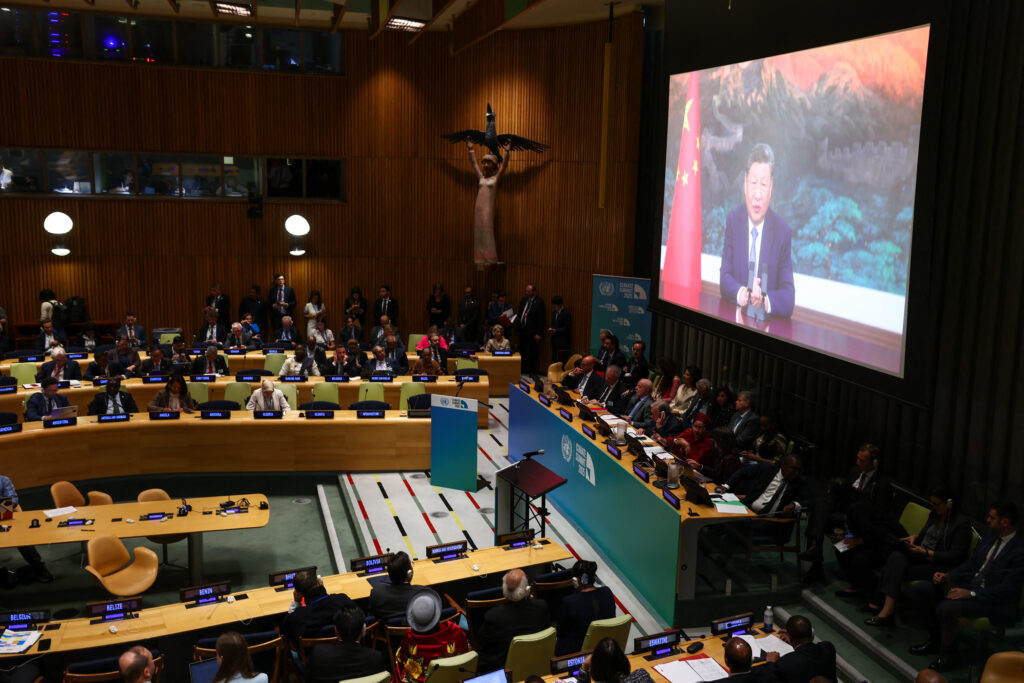Two years in, delegates from more than 175 countries working to craft a global plastics pollution treaty remain widely divided. Whether an agreement emerges from a final scheduled round of negotiations this month is anyone’s guess.
The current 70-page draft contains over 3,000 disputed words or sentences—an unworkable text with just a week of formal talks remaining.
As a workaround, Ecuador Ambassador Luis Vayas Valdivieso, who will chair the upcoming United Nations meeting to be held from Nov. 25 to Dec. 1 in Busan, South Korea, has developed a shorter, streamlined draft called a “non-paper” because of its unofficial status. It leaves key treaty provisions without suggested text. And there is no assurance that delegates will be able to reach the consensus needed to even agree to resume their talks in Busan based on that document instead of the more unwieldy one.

Adding to the uncertainty of the meeting, dubbed “INC5” because it’s the fifth gathering of the intergovernmental negotiating committee, is how the Biden administration and other countries will react to Donald Trump’s impending return to the White House. Plastics are made from fossil fuels, which Trump enthusiastically supports.
While environmental advocates have complained that the Biden administration’s “low ambition” has hindered negotiations for a strong plastics treaty since they began in December 2022, the State Department has sent recent signals that it intends to take a more aggressive posture toward the problem of plastic pollution, including a willingness to accept provisions that could reduce plastic production.
Environmental advocates are urging the Biden administration to seize on that sentiment and work for the strongest treaty possible and not worry about how a future Trump administration might respond, or how long it might take to secure treaty approval by the necessary two-thirds of the Senate—often an iffy prospect in the United States.
Their thinking is that the U.S., the world’s largest producer of plastic waste and among its top plastic makers, could be persuaded or pressured to join a strong plastics treaty in the future, should voters someday elect a more amenable president and Senate. But if the outcome is a weak treaty, the diplomatic work that began a decade ago to curb plastic waste will end up in failure, they fear.
In that circumstance, the world “will be left with a meaningless treaty that would satisfy Russia and Saudi Arabia—that is, a treaty that would enrich petrochemical companies and do nothing to address the plastic pollution crisis,” said Daniela Duran Gonzalez, a senior legal campaigner with the Center for International Environmental Law, an environmental group.
In a world choking on plastic waste, the UN has described plastics as part of a triple planetary threat of climate change, biodiversity loss and pollution. It cripples and kills marine life. And when plastic, which is made with various toxic chemicals, breaks down into the smallest of microscopic pieces, these micro- or nano-plastics get into human bodies, where they have been found in blood, brains and placenta.
The microplastics carry chemicals that can harm human health, potentially affecting fertility and biological systems that regulate our hormones, metabolism and brain activity.
Some 40 percent of plastic products are used once and tossed.
CIEL and other groups, including Greenpeace, the Center for Biological Diversity, The Descendants Project and Fenceline Watch, are calling for treaty language that would put restrictions on the global trade of plastics for countries that are not a party to the agreement. That could hurt the bottom line of U.S. plastics producers, providing an economic incentive for U.S. participation, they argue.
“We encourage the United States negotiating team to recall their responsibility to protect human health, the climate and human rights, and leave everything on the field in Busan,” Gonzalez said. “We urge them to stay firm to their commitments to reduce plastic production to deliver a better future for us all.”
The State Department referred comments to the White House, which did not respond.
Petrochemicals are the building blocks of nearly all plastics, and the American Chemistry Council, an industry lobbying group, said in a written statement that it looks forward to working with the incoming Trump administration to further boost petrochemical production.
The ACC also said it wants governments meeting in South Korea to achieve an agreement by the end of INC5, one that focuses on allowing countries to develop action plans to stop plastic waste from becoming pollution—not to reduce the amount of plastic being made.
“We will work with the administration and Congress to encourage adoption and implementation of a workable, equitable treaty,” said Ross Eisenberg, president of America’s Plastic Makers, an ACC program, in a written statement. “U.S. participation is essential for achieving an agreement that brings U.S. innovations that can help eliminate pollution to the global community.”
A Global Test of Resolve
The diplomatic challenges are playing out against a backdrop of increasingly urgent warnings about the expansive harm plastic pollution inflicts.
Plastic production continues to soar, with petrochemical companies producing 460 million metric tons in 2019, an amount that could triple by 2060, according to the Paris-based Organization for Economic Co-operation and Development. Across the globe, less than 10 percent gets recycled.
Using a “planetary boundaries” framework to examine the mounting evidence of the influence of plastics on the environment and human health, a Swedish-led research team this month has shown that plastics pollution affects all pressing global environmental problems. That includes climate change, biodiversity loss and ocean acidification.
The planetary boundaries framework allows an assessment of the limits of what could be called a safe operating space for the Earth and its ecological systems.
“We now find plastics in the most remote regions of the planet and in the most intimate, within human bodies,” said Bethanie Carney Almroth, a professor at the University of Gothenburg and co-author of the new paper, published in the peer-reviewed journal One Earth.


Because plastics create pollution at every point of their life cycle, “the solutions we strive to develop must be considered with this complexity in mind, addressing the full spectra of safety and sustainability to protect people and the planet,” said Almoth, a steering committee member of the Scientists’ Coalition for an Effective Plastics Treaty, a group that has offered scientific advice to participating delegates.
Reaching an agreement will be a heavy lift for the negotiators, she acknowledged in an interview.
“It’s very high stakes,” she said, particularly with economic considerations. “It can change entire markets, and there are ties via the fossil fuel and petrochemical industry to national economies.”
The process is a global test of resolve for the United Nations Environment Assembly (UNEA), which began focusing on the more limited problem of marine litter a decade ago. In March 2022, UNEP gave environmental advocates much of what they were looking for: a broad definition of the problem to include pollution across the plastics life cycle, from production to design to disposal, and a charge to draw up an agreement by the end of this year.
“This final negotiating round represents both a climax and a crossroad,” said Aaron Wu, a London-based expert in international environmental law and former trade and environmental policy advisor to the Australian government, in an email.
“The draft text remains an ideological battlefield,” he said. “The boldest aspirations call for comprehensive bans on harmful plastics and expanded accountability on plastics producers, although realpolitik inevitably shapes these negotiations’ undercurrents. Many wealthier countries continue to advocate for stringent measures, while some lower-income countries voice the need for more time and resources to transition equitably.”
Busan itself is a fitting venue, symbolizing the tensions, Wu said. It’s where “the might of Asia’s marine economy meets an ocean increasingly covered beneath waves of plastic.”
The question, he said, is whether Busan will be seen as a “lighthouse, guiding us toward more sustainable horizons, or a warning beacon for sinking hopes.”
Debate Over Mandatory Versus Voluntary Approaches
What concerns environmental advocates about Valdivieso’s non-paper is the wriggle-room language in it that suggests the treaty might be focused more on voluntary actions of participating countries, despite the stated objective of reaching “a legally binding instrument on plastic pollution.”
The document offers an outline of what a treaty might include. For example, there’s draft language promoting better design of plastic products so they are more easily and safely reused or recycled.
Another section would have parties to the agreement “take measures to manage, reduce, and where possible, eliminate emissions and releases” to the environment from plastic production. That section also has similar wording regarding releases of plastic pellets, flakes and microplastics into the environment.
Other provisions would seek to improve systems for managing plastic waste and cleaning up existing plastic pollution.
The draft envisions that each country would develop a national plan that would “describe the measures it intends to take to implement its obligations.”


Missing is specific suggested language on how to finance the treaty and its commitments, how to address concerns about the most toxic chemicals contained in plastics and what to do about plastic production. The draft contains the vague suggestion of having the parties agree “to cooperate to achieve a global objective of sustainable levels of production.”
Environmental advocates have feared from the outset that any treaty that relies more on voluntary approaches around national plans will fall short. They point to the 2015 Paris Agreement around climate change as an example. That agreement has so far failed to get greenhouse gases under control as global temperatures keep rising.
“If we’re serious about addressing this, we need to have mandatory obligations for member states that are legally binding, especially around the production piece,” said Graham Forbes, the global plastics project leader at Greenpeace.
Plastics are exacerbating climate change, accelerating dangerous biodiversity losses and presenting an “immediate health risk to people all over the world,” he said. “The data and the science coming out on that is more dire every day. No one is … left unimpacted by this.”
This story is funded by readers like you.
Our nonprofit newsroom provides award-winning climate coverage free of charge and advertising. We rely on donations from readers like you to keep going. Please donate now to support our work.
Donate Now
The progress in recent years is that plastics are now seen as the significant health and climate concern that they are and not just an annoying waste management problem, said Bjorn Beeler, executive director of the International Pollutants Elimination Network (IPEN), a global network of more than 600 nongovernmental organizations in 128 countries working to eliminate toxic pollutants.
But he said he’s worried that the current, though unofficial, draft sets the bar too low, and does not bode well for the outcome.
“When you get to the final negotiations, the energy and ambition do not move up” from there, he said.
Businesses Take Different Approaches to Treaty
Oil, gas and petrochemical industries aren’t the only business groups sending representatives to Busan.
One of those is named Champions of Change, and it calls for a cap on plastic production; a phaseout of single-use plastics; specific targets for the re-use of plastics; and the centering of environmental justice in the treaty. Some 350 businesses in that coalition, including Ben & Jerry’s and Lush Cosmetics, have signed on to an open letter saying they are “committed to endorsing, creating and driving truly circular solutions that follow the zero waste hierarchy, prioritizing reduction and reuse (including repair, refurbishment and remanufacture), and to working collaboratively to implement the treaty.”
That effort was convened by Greenpeace, Break Free From Plastic and the Plastic Pollution Coalition.
“This global initiative gives companies a platform to leverage their influence and push for a strong global plastics treaty that will drastically cap and cut plastic production,” said Sam Chetan-Welsh, a senior policy advisor for Greenpeace. “Plastic production reduction doesn’t have to come at the cost of a healthy business landscape and is, in fact, an enabler of genuinely sustainable solutions.”
Another collection of businesses, the Business Coalition for a Global Plastics Treaty, published a letter on Oct. 28, calling on governments to unite and deliver a treaty “that is fit for purpose.” because “it is clear that voluntary efforts alone are not enough to address plastic pollution at scale.” It was signed by 22 CEOs, including leaders of plastic-reliant companies such as Nestle, PepsiCo, Unilever and SC Johnson.
They called for agreement on restricting and phasing out chemicals of concern; better packaging design; extended producer responsibility, which tends to mean that companies making or selling plastic products must help pay for collection, recycling or disposal; and a mandate for participating governments to strengthen the agreement over time.
The coalition has also signed on to something called “The Bridge to Busan,” a declaration signed by 41 countries and the European Union that includes a recognition that the levels of plastic production must be limited in some way.
“Studies show that the world cannot achieve its goals of ending plastic pollution and limiting global average temperature rise to less than 1.5° Celsius if the unsustainable production of primary plastic polymers is not addressed,” the document declares. “Left unaddressed, production of primary plastic polymers is projected to increase exponentially through 2050 and could overwhelm national waste management and recycling programs, even after significant improvements supported by the new instrument.”
“Plastic production reduction doesn’t have to come at the cost of a healthy business landscape.”
— Sam Chetan-Welsh, Greenpeace senior policy advisor
The environmental group World Wildlife Fund has worked to convene the Business Coalition and its 260 participating companies along with the Ellen MacArthur Foundation. Erin Simon, a vice president of WWF, said in an interview that she sees potential compromise around plastic production.
The Bridge to Busan “doesn’t talk about a plastic cap,” she said. “It is the need to use less, which I think is the language you’re starting to see a lot of folks coalesce around.”
With so little time left, every hour of negotiation will be critical, said IPEN’s Beeler. By day three of the meeting, “we’ll find out if we’re really in a dangerous situation that there’s no clarity of where we’re going.”
The public, he said, will need to watch carefully for narratives that emerge from the Busan meeting. If the result is a weak treaty, participating governments might still describe it as a major environmental win.
An agreement that “basically puts a Band-Aid across a cancerous tumor” with declarations that “now you’re healed: That’s the worst situation,” he said.
About This Story
Perhaps you noticed: This story, like all the news we publish, is free to read. That’s because Inside Climate News is a 501c3 nonprofit organization. We do not charge a subscription fee, lock our news behind a paywall, or clutter our website with ads. We make our news on climate and the environment freely available to you and anyone who wants it.
That’s not all. We also share our news for free with scores of other media organizations around the country. Many of them can’t afford to do environmental journalism of their own. We’ve built bureaus from coast to coast to report local stories, collaborate with local newsrooms and co-publish articles so that this vital work is shared as widely as possible.
Two of us launched ICN in 2007. Six years later we earned a Pulitzer Prize for National Reporting, and now we run the oldest and largest dedicated climate newsroom in the nation. We tell the story in all its complexity. We hold polluters accountable. We expose environmental injustice. We debunk misinformation. We scrutinize solutions and inspire action.
Donations from readers like you fund every aspect of what we do. If you don’t already, will you support our ongoing work, our reporting on the biggest crisis facing our planet, and help us reach even more readers in more places?
Please take a moment to make a tax-deductible donation. Every one of them makes a difference.
Thank you,

















